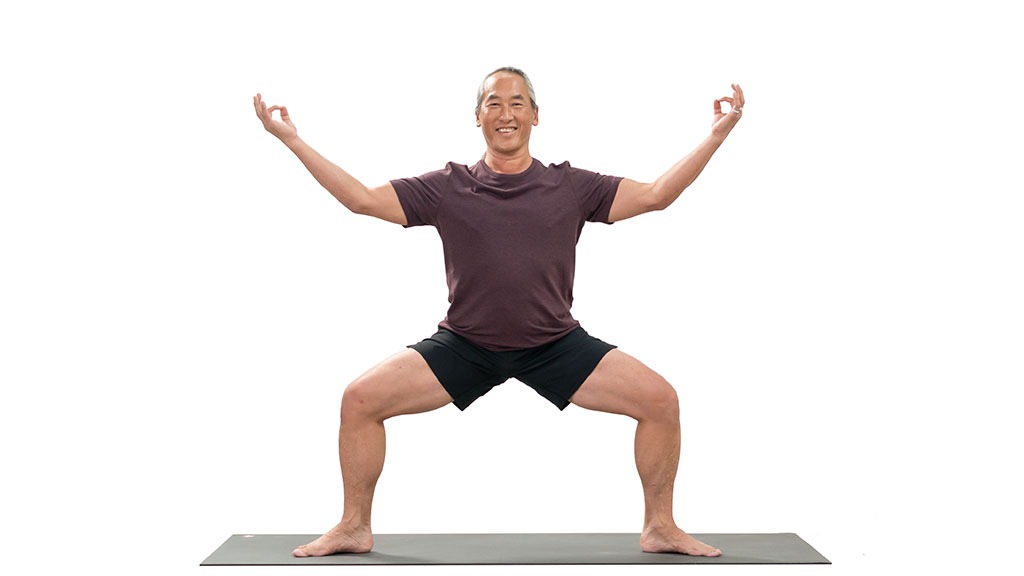Temple Pose, also known as Utkata Konasana or Goddess Pose, is a grounding and empowering yoga posture that strengthens the lower body, improves flexibility, and fosters inner balance. At VeryFit Life, we believe this pose is essential for anyone looking to build physical strength while cultivating mindfulness.
What is the Temple Pose in Yoga?
The Temple Pose is a standing posture that engages the thighs, hips, and core. This pose requires you to open your hips, lower your body into a wide squat, and stretch your arms upward or outward, creating a powerful and stable stance. Its symbolism reflects grounding energy and inner strength.
Benefits of Practicing the Temple Pose
Adding Temple Pose to your yoga practice provides numerous physical and mental benefits:
-
Strengthens the Lower Body: Targets the thighs, calves, glutes, and hips.
-
Enhances Flexibility: Opens up the hip joints and stretches the inner thighs.
-
Improves Posture: Encourages alignment and strengthens the back.
-
Boosts Stability: Improves balance and focus.
-
Promotes Mindfulness: Encourages a sense of grounding and inner calm.
How to Perform the Temple Pose
Step-by-Step Instructions
-
Begin in a Standing Position:
-
Stand with your feet wider than hip-width apart.
-
Turn your toes slightly outward, about 45 degrees.
-
-
Lower into a Squat:
-
Bend your knees and lower your hips, ensuring they align with your knees.
-
Keep your knees tracking over your toes to avoid strain.
-
-
Engage Your Core:
-
Tighten your abdominal muscles to support your lower back.
-
Lengthen your spine and avoid leaning forward.
-
-
Position Your Arms:
-
Raise your arms upward or extend them sideways at shoulder height.
-
Keep your shoulders relaxed and your chest open.
-
-
Hold and Breathe:
-
Maintain the pose for 3-5 deep breaths, focusing on your stability and alignment.
-
-
Release:
-
Straighten your legs and return to a standing position.
-
Tips for Perfecting the Temple Pose
-
Adjust Your Stance: Widen your feet or lower your squat to suit your flexibility and strength.
-
Engage Your Core: Keep your abdominal muscles activated for stability.
-
Relax Your Shoulders: Avoid tensing your neck or shoulders as you hold the pose.
-
Breathe Deeply: Focus on steady, even breaths to stay grounded.
-
Modify if Necessary: Use a wall or chair for support if balance is a challenge.
Common Mistakes to Avoid
-
Knees Collapsing Inward: Ensure your knees align with your toes to avoid strain.
-
Overarching the Back: Engage your core to maintain a neutral spine.
-
Shallow Squat: Lower your hips to knee level for maximum effectiveness.
-
Holding Your Breath: Maintain a steady breathing pattern to stay relaxed.
Variations of the Temple Pose
1. Supported Temple Pose
-
Use a wall for support by leaning your back against it while holding the pose.
2. Temple Pose with a Twist
-
Place one elbow on your opposite thigh and twist your torso to deepen the stretch.
3. Dynamic Temple Pose
-
Move in and out of the squat position to build endurance and flexibility.
How to Incorporate the Temple Pose into Your Routine
1. Warm-Up Pose
Use the Temple Pose as part of your warm-up to activate your hips and legs.
2. Strength-Building Sequence
Incorporate it into lower-body-focused flows to enhance strength and endurance.
3. Cool Down and Stretch
Pair it with gentle stretches like Forward Fold to release tension after a workout.
Safety Tips for Practicing the Temple Pose
-
Warm-Up First: Prepare your muscles with light stretches or dynamic movements.
-
Use Proper Footwear: Practice on a yoga mat or barefoot for stability.
-
Modify for Comfort: Adjust your squat depth or use props if needed.
-
Listen to Your Body: Avoid any movements that cause pain or discomfort.
Frequently Asked Questions About the Temple Pose
1. Is the Temple Pose suitable for beginners?
Yes, beginners can start with a higher squat and gradually deepen the pose as they gain strength and flexibility.
2. What muscles does the Temple Pose target?
It targets the thighs, glutes, calves, core, and hip flexors.
3. Can I practice this pose during pregnancy?
With proper modifications and guidance from a certified instructor, the Temple Pose can be safe and beneficial during pregnancy.
4. How long should I hold the Temple Pose?
Start with 3-5 breaths and gradually increase the duration as you build strength.


